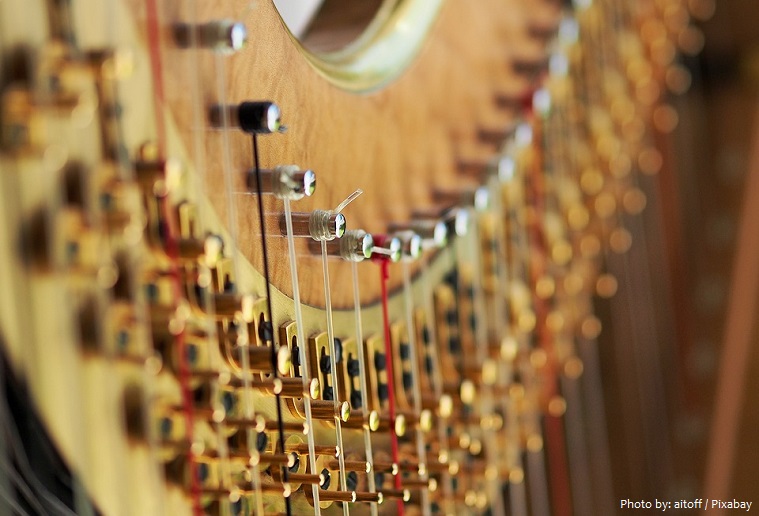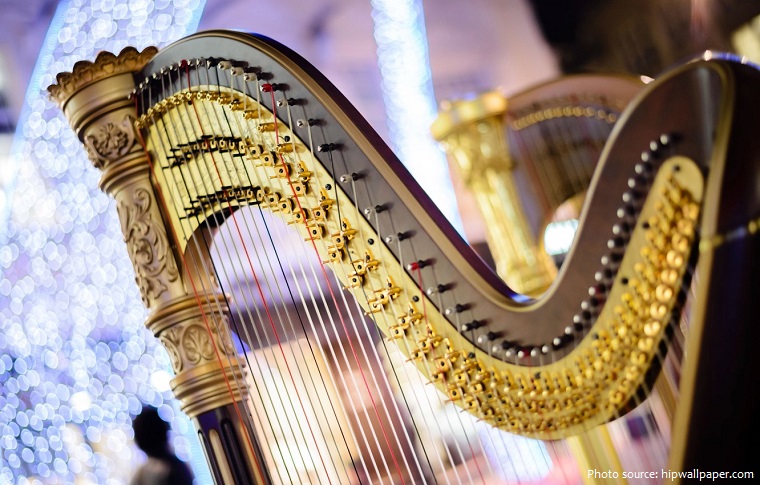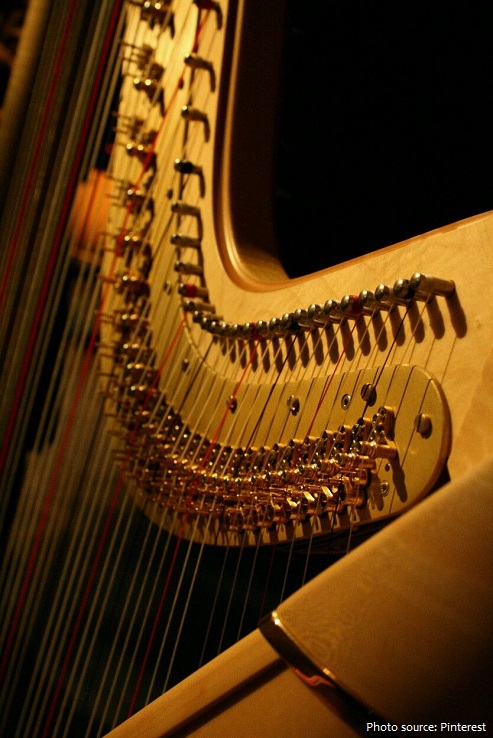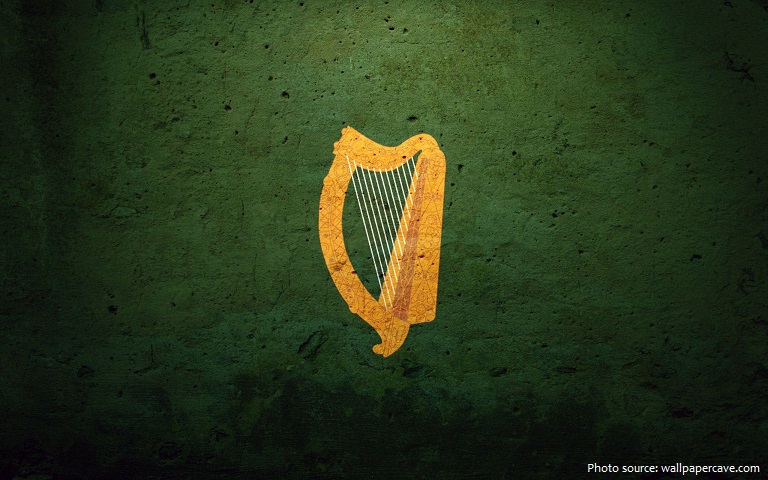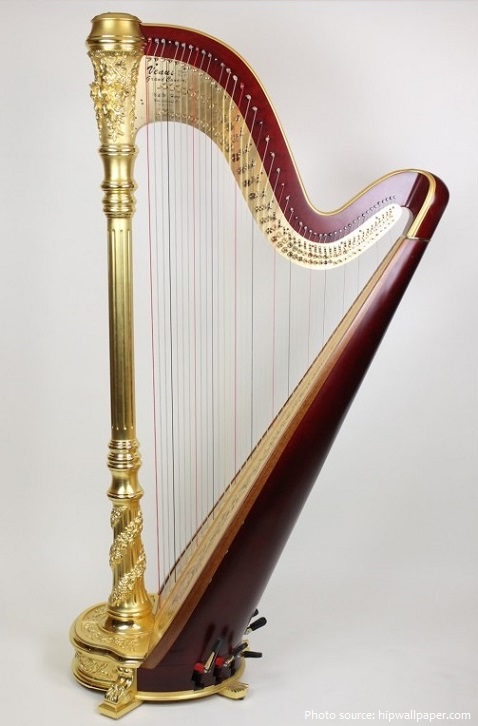The harp is a stringed musical instrument.
It has a number of individual strings running at an angle to its soundboard.
The strings are plucked with the fingers.
Each string produces one note, the gradation of string length from short to long corresponding to that from high to low pitch.
Harps vary globally in many ways. In terms of size, many smaller harps can be played on the lap, whereas larger harps are quite heavy and rest on the floor. Different harps may use strings of
catgut, nylon, metal, or some combination.
All harps have a neck, resonator, and strings, frame harps or triangular harps have a pillar at their long end to support the strings, while open harps, such as arch harps and bow harps, do not.
The resonator is usually of wood or skin. In arched, or bow-shaped, harps the neck extends from and forms a curve with the body.
The two main kinds are folk harps and pedal harps.
• The folk harp is the older kind of harp, the oldest dating back to 3000 BC in Ancient Egypt. In these harps, each string can only make one note at a time. They are usually tuned so that playing
each string in order sounds like playing all the white notes on a piano in order.
• The pedal harp was invented during the 1800s by a man in France. This is the kind of harp that is heard in most classical music and is used in the modern symphony orchestra, and for this reason it is often called a concert harp.
Each harp is a unique work of art. The design of the harp depends on the needs of the performer.
The harp is the oldest known stringed instrument.
Harps have been known since antiquity in Asia, Africa and Europe, dating back at least as early as 3500 BC.
The earliest harps and lyres were found in Sumer, 3500 BC, and several harps were excavated from burial pits and royal tombs in Ur.
The instrument had great popularity in Europe during the Middle Ages and Renaissance, where it evolved into a wide range of variants with new technologies, and was disseminated to Europe’s colonies, finding particular popularity in Latin America.
Although some ancient members of the harp family died out in the Near East and South Asia, descendants of early harps are still played in Myanmar and parts of Africa, and other defunct
variants in Europe and Asia have been utilized by musicians in the modern era.
In the Americas, harps are widely but sparsely distributed, except in certain regions where the harp traditions are very strong. Such important centres include Mexico, the Andean region, Venezuela, and Paraguay. They are derived from the Baroque harps that were brought from Spain during the colonial period.
The harp has been used as a political symbol of Ireland for centuries. Its origin is unknown but from the evidence of the ancient oral and written literature, it has been present in one form or another since at least the 6th century or before.
According to tradition, Brian Boru, High King of Ireland (died at the Battle of Clontarf, 1014) played the harp, as did many of the gentry in the country during the period of the Gaelic Lordship
of Ireland (ended c. 1607 with the Flight of the Earls following the Elizabethan Wars).
In traditional Gaelic society every clan and chief of any consequence would have a resident harp player who would compose eulogies and elegies in honour of the leader and chief men of the clan.
The harp was adopted as a symbol of the Kingdom of Ireland on the coinage from 1542, and in the Royal Standard of King James VI and I in 1603 and continued to feature on all English and United Kingdom Royal Standards ever since, though the styles of the harps depicted differed in some respects.
The harp is traditionally used on the flag of Leinster.
The Irish beer Guinness uses a harp in its logo. The harp is based on a famous 14th century Irish harp known as the “O’Neill” or “Brian Boru” harp which is now preserved in the Library of Trinity College Dublin.
The modern English word “harp” comes from the Old English hearpe – akin to Old High German harpha.
A person who plays a pedal harp is called a “harpist” – a person who plays a folk-harp is called a “harper” or sometimes a “harpist” . either may be called a “harp-player”, and the distinctions are not strict.
The highest altitude harp performance is 4,954 m (16,253 ft 3.37 in), and was achieved by Siobhan Brady (Ireland), Desmond Gentle and Anna Ray (both UK), at Singla Pass, India, on 6 September 2018.
The largest harp ensemble involved 420 participants directed by Luis Szaran at an event organized by “Sonidos de la Tierra” (Paraguay) during the 7th Festival Mundial del Arpa held in Asunción, Paraguay, on 26 October 2013.
The longest harp marathon by an individual lasted for 25 hours and 34 minutes and was achieved by Carly Syta (USA) at Notre Dame Academy High School, California, USA, on 16-17 October 2010.

